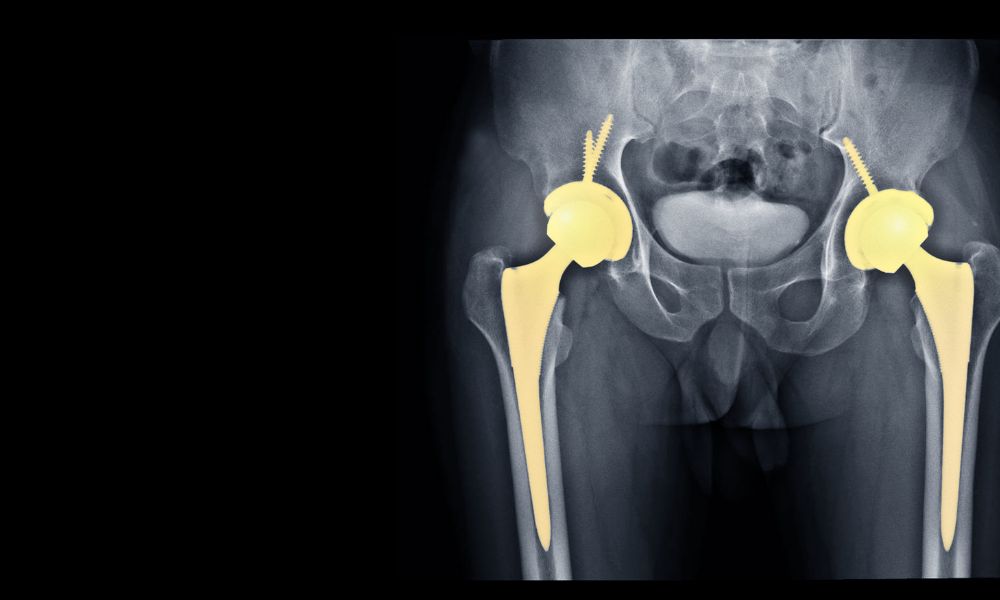Best Hip Replacement Surgeon in Nagpur

Best Hip Replacement Surgeon
In a total hip replacement procedure, commonly referred to as total hip arthroplasty, the impaired bone and cartilage are excised and substituted with artificial components.
- The compromised femoral head is excised and substituted with a metallic stem, which is inserted into the hollow core of the femur. This femoral stem can be affixed using cement or may be secured through a “press fit” method within the bone.
- A metallic or ceramic sphere is then positioned atop the stem, serving as a replacement for the excised femoral head.
- The damaged cartilage lining the socket, known as the acetabulum, is also removed and replaced with a metallic socket. In some cases, screws or cement are utilized to ensure the socket remains securely in place.
- To facilitate a smooth gliding surface, a spacer—composed of plastic, ceramic, or metal—referred to as a liner, is inserted between the newly placed ball and the socket.
Common Causes of Hip Pain
- Core Muscle Injury (Sports Hernia or Athletic Pubalgia) Groin pain may suggest a core muscle injury, which can manifest as a strain or tear in the lower abdominal muscles or surrounding soft tissues. This type of injury is frequently observed in weekend athletes, particularly those participating in sports that involve significant twisting and turning without proper conditioning. Treatment typically involves resting the affected muscles for several weeks, although surgical intervention by a general surgeon may be required in more severe cases.
- Bursitis Discomfort on the outer hip, thigh, or buttocks may be attributed to bursitis, which is the inflammation of the bursae—fluid-filled sacs that serve to cushion tendons and muscles from friction against bones. Engaging in activities such as walking long distances, climbing stairs, or lying on the affected side can exacerbate the pain. Bursitis is more prevalent in older adults, particularly those over the age of 60. Treatment options include rest, application of ice compresses, and the use of over-the-counter anti-inflammatory medications. In certain instances, cortisone injections may be suggested to alleviate inflammation.
- Tendonitis Sensitivity in the hip flexor or groin region during movement or upon touch may indicate the presence of tendonitis. This condition arises when repetitive strain or overuse leads to minor injuries in the tendons that connect muscles to bones. Activities that involve repetitive motions, such as kicking in soccer, can heighten the risk of developing tendonitis. Treatment generally mirrors that of bursitis, focusing on rest, ice application, and anti-inflammatory medications.
- Labral Tears The labrum is a cartilage ring that encircles the hip socket, ensuring the stability of the thighbone. A tear in this cartilage can result in ongoing hip or groin pain, limited mobility, and sensations of locking, catching, or clicking. Labral tears are particularly common among athletes, dancers, and individuals with hip structural abnormalities. Treatment often involves minimally invasive surgical procedures aimed at repairing the tear and reshaping the hip bone to restore proper alignment and alleviate pain.
- Gynecological or Pelvic Floor Concerns: In certain instances, hip pain may stem from issues related to the pelvic region rather than the hip joint itself. Conditions such as endometriosis, uterine fibroids, or gastrointestinal disorders can lead to discomfort that may be misinterpreted as a hip injury. Treatment: A comprehensive medical assessment is essential. Based on the findings, a referral to a gynecologist or gastroenterologist may be necessary
- Hip Impingement (Femoral Acetabular Impingement – FAI): Engaging in high-intensity activities, including CrossFit, barre classes, or obstacle races, can result in abnormal fusion of the hip bones, which restricts mobility and induces pain. This condition, referred to as femoral acetabular impingement (FAI), may elevate the risk of developing early osteoarthritis. Treatment: The initial approach typically involves physical therapy. In more severe instances, surgical intervention may be required to realign the hip bones.
- Osteoarthritis is a leading cause of chronic hip pain, characterized by joint stiffness, swelling, and the breakdown of cartilage. This condition often arises from improperly formed hip bones, leading to increased friction and wear over time. Contributing factors include aging, obesity, high-impact sports, and prior injuries, which can worsen osteoarthritis. Treatment: Management strategies generally encompass physical therapy, pain relief medications, and, in advanced cases, surgical options such as hip replacement surgery.
The orthopedical analysis
Orthopedic evaluation plays a crucial role in the precise diagnosis and management of hip-related disorders. Medical professionals utilize a comprehensive approach that includes physical assessments, imaging modalities, and the patient’s medical history to determine the underlying cause of hip discomfort. Imaging techniques such as X-rays, MRI scans, and CT scans yield intricate images of bones, joints, and soft tissues, facilitating the identification of issues such as fractures, arthritis, labral tears, or structural irregularities.
During the physical examination, orthopedic experts evaluate the patient’s range of motion, muscle strength, joint stability, and areas of tenderness. Functional movement assessments are conducted to identify mobility limitations or pain triggers associated with specific activities. Furthermore, the patient’s history, encompassing activity levels, previous injuries, and lifestyle choices, provides essential context for an accurate diagnosis.
Timely intervention is critical, as neglecting hip conditions can result in chronic pain, diminished mobility, or irreversible joint damage. Orthopedic specialists frequently work in conjunction with physical therapists to develop tailored rehabilitation programs that emphasize pain relief, muscle strengthening, and the restoration of joint function. In more severe instances, surgical interventions, including minimally invasive techniques or joint replacement surgeries, may be warranted.
In summary, orthopedic evaluation not only seeks to alleviate immediate symptoms but also aims to avert future complications, enabling patients to sustain an active and pain-free lifestyle.